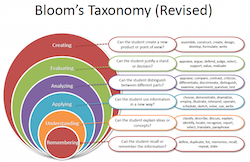10 Apr 2015
When smart people
challenge each other to grow,
great things happen.
~The ChicagoRuby Motto
If you’re a developer itchin’ to ramp up your Ruby skills, Chicago is a great place to be. The local Ruby user group, ChicagoRuby, continues to expand in time, space, expertise, and numbers. The group is over 3,200 strong, with six events each month plus the annual WindyCityRails conference.
The newest locations on ChicagoRuby’s monthly list are BLUE1647 and 1871.
Continue reading →
31 Mar 2015
The Amazon Dash Button is for customers who crave instant gratification. We might think of Dash as a brilliant blend of the Staples Easy Button, WiFi, and Amazon’s existing database of credit card numbers.

Continue reading →
20 Mar 2015

Bloom’s Taxonomy is a framework that breaks the learning process into stages. According to Bloom, learning begins with rote memorization and the process progresses upward until we can apply what we’ve learned in creative new ways.
Youthful Bias
Most of my formal education was science or engineering oriented. I regarded science and engineering as the pinnacle of learning. The extreme position of my youth: All logic fell within math and science, while history, language arts, and other non-science areas were just memorization.
Bloom’s research pushed me beyond my original thinking. Memorization and creativity are vital to all areas of knowledge. Here’s how.
Continue reading →
19 Mar 2015
Users of the Linux or OS X command line know that they can hit the up arrow to view the previously executed command. However, this behavior is missing from the mit-scheme read-evaluate-print-loop (REPL). mit-scheme is the language used in SICP.
For example, hitting the up arrow in the Scheme REPL gives us this non-useful result: ^[[A. The previous command is not repeated.
How do we add up-arrow functionality to the mit-scheme REPL? By using rlwrap.
Continue reading →
12 Mar 2015
You have to figure out what your own aptitudes are. If you play games where other people have the aptitudes and you don’t, you’re going to lose. And that’s as close to certain as any prediction that you can make. You have to figure out where you’ve got an edge. And you’ve got to play within your own circle of competence.
~Charlie Munger, Vice Chairman, Berkshire Hathaway
Some journalists speculate that Apple is building a car because they recently hired some automotive engineers away from Tesla.
Continue reading →





